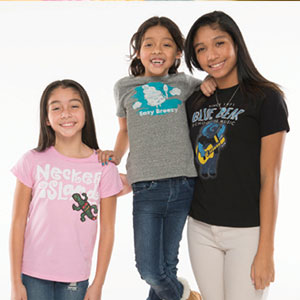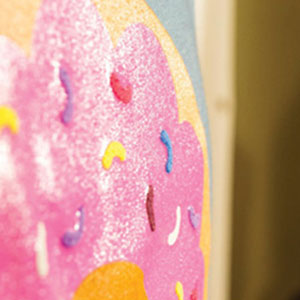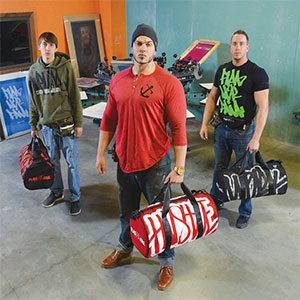Product Hub March 30, 2015
It Takes Imagination
Creative vision and expertise can make the T-shirt a branding powerhouse.
The advertising specialty industry sells $1.8 billion worth of T-shirts – enough to buy an NBA franchise or a couple round-trip tickets to the Moon. Its immense popularity (easily the number-one item in this industry) is no mystery: a recipe of enticing affordability combined with "Just Add Water" sales ease. No other apparel item has become so integrated into the fabric of our lives.
Ringspun cotton is a top choice for T-shirt fabrics, and can be found in the nano-T T-shirt (4780) from Hanes Branded Printwear (asi/59528; circle 103 on Free Info Card).
Yet in many ways the T-shirt is a victim of its overwhelming success – often treated as the obvious, slap-your-logo here promotional option and easily pigeonholed as a bargain-basement afterthought. "[The distributor] takes the artwork and whatever cheap T-shirt is on sale and says 'Here you go printer, make it happen,'" says Tom Davenport, founder and president of contractor decorator Motion Textile (asi/72662). "To me, that is how you end up with that commodity T-shirt nobody really cares for."
It doesn't have to be that way. Excellent T-shirts are bred through a perfect marriage of garment, design and printing. They're the product of a successful union between customer, distributors and decorator – one with give-and-take that allows each party to exercise their expertise. And they succeed thanks to an intimate understanding of branding and the ultimate goal of the promotion.
A Quality Start
T-shirts were once just the off-duty weekend look of the American public, but times have changed. Because T-shirts are now worn so often and so widely, the demand for a great product has been raised significantly. "Quality has turned into a big segment of it," says Greg Brown, COO of Keya (asi/64602), which specializes in ringspun cotton tees. "If you have an inferior product, it's not going to sell, and people are going to know very quickly."
Just as you can't put lipstick on a pig, you can't turn a substandard blank into a great branded tee, no matter what sort of printing wizardry you lay down. To create a compelling T-shirt, you have to start with quality. "We've all had that experience of buying a cheap T-shirt that you love – but after you wash it, never being able to wear it again," says Rachel Newman, director of marketing and sales for Hanes Branded Printwear (asi/59528). "Quality is that favorite tee, from a concert, from college, maybe from a vacation, that 10 years later is still at the top of the drawer."
So what makes a great garment? Fabric is a fundamental starting point (see page 50). Polyester fabrics have improved significantly through innovation as performance wear demand surges. Tri-blends and other fabric mixtures have changed the look and feel of fashion tees. And with cotton, ringspun still remains the gold standard, due to its hand and its ability to be printed. "The Hanes nano-T T-shirt is a great example," says Newman. "While many tees have traditionally used a thicker gauge yarn, here we've used a finer gauge yarn. This, in addition to the higher stitch density, provides a smoother surface to print on, whether for direct-to-garment or any traditional screen-print process."
What's done with the fabric is equally crucial. The custom shirts and other items designed by Golden Goods (asi/57695) include custom garment-dying and vintage washing for an exceptionally soft hand. Fit, too, is vital. "It's that one millimeter of 'fittedness' versus being too loose or too tight," says Jeff Scult, Golden Goods co-founder and president. "We're in the nuance business, and we love that. It starts with the fabric but continues with everything else to bring it together."
On their end, decorators have the tools to make a shirt stand out. Often that can simply be high-quality printing with soft-hand inks and technical precision. "Because we can do all sorts of great printing techniques, [our customers] will send us a logo and say 'Okay, what can we do to jazz this print up?' " says Davenport. "Yet all the time I'll look at something and say 'It's a great design. We don't need to do anything except print it well.' "
Specialty inks and techniques certainly have a place when it makes sense and enhances the look. Between 30%-40% of the clients with Shockwaves Promotional Apparel (asi/87144) utilize Greg Gaardbo's unique combinations of sublimation, sequins, discharge, foil and more. Culture Studio (asi/700559) offers a wealth of options, from gels and wet inks to jumbo and all-over prints – all modestly priced for as little as 50 cents for specialty ink. The decorator recently printed a shirt with an image of a doughnut that had puffed three-dimensional sprinkles and a gel overlay that made it look "like you could lick the frosting on it," says President Rich Santo. It wasn't that way originally, he adds: "That print just came to us as a flat image in Photoshop, and we used our vision to make it a special print instead of just putting plastisol ink on the board."
"We make suggestions instead of doing whatever the client says, as if we're mindless robots just printing the stuff."
Rich Santo, Culture Studio (asi700559)

Golden Goods (asi/57695; circle 108 on Free Info Card) specializes in custom garment-dyed shirts with large center-chest designs for maximum branding impact.

Culture Studio (asi/700559; circle 107 on Free Info Card) took a flat image of a doughnut and brought it to life with a gel overlay for the frosting and puff ink for the sprinkles.
Brand Management
Dollars to doughnuts, an essential mandate of Culture Studio and other decorators is to elevate a print. That means addressing the forehead-smacking requests (customers who want sublimation but don't wear polyester, for example). But it's also suggesting needed alternatives while walking the line between quality and price. In Culture Studio's case, that could be substituting full-color discharge for sublimation, or replacing an all-over design with a jumbo print and additional printing on the sleeves. Says Santo: "I think that's where our value is added. … [We make suggestions] instead of doing whatever the client says, as if we're mindless robots just printing the stuff."
Printed T-shirts are at their best when decorators utilize their expertise. Fabrics and logos provided by the distributor and end-user aren't always a perfect match, and apparel print design is very different from traditional graphic design, says Davenport. A small element of a design left unchecked can create a tremendous headache in the printing process and ultimately add unneeded cost. "If we're not brought into the [creative] process," Davenport says, "we have to sometimes go through great pains to achieve a graphic with near 100% accuracy." Motion Textile has increasingly been asked to develop a concept at the very outset, which can ensure the best results.
Beyond the ink, decorators can prove their value by acting as a brand manager. Places like Golden Goods shape an idea by getting into deep brand discussions with distributors and end-users while determining the audience and purpose of the apparel. From there, it will focus on certain verbiage or elements that continually appear in the conversation and company's marketing. The supplier specializes in distressed center-chest prints, but Scult says that valuable real estate may be best reserved for a slogan or message. The company's logo can then be featured as a button or on the inside with tagless printing. It's a simple goal: make something people want to wear. "Our passion is to deepen the connection between brands and their fans," Scult says.
Fly The Flag
Creating a one-of-a-kind shirt isn’t always the result of high-end equipment or decades of expertise. In the case of Robert Bailey, founder of Flag Nor Fail, it was a result of happy accidents combined with an artistic streak.

Robert Bailey (center) created the Flag Nor Fail clothing line’s look by happenstance, but now uses the V2000HD manual press from Vastex International (circle 109 on Free Info Card) to achieve consistent results.
With a lack of screen-printing knowledge, Bailey laid down multiple colors and prints over each other. The results were compelling: hand-script fonts over large block fonts that ended up with what looked like graffiti. The clothes found an audience, and through social media alone, Flag Nor Fail was growing at 20% a month. But the old press that helped birth the company’s aesthetic was becoming a hindrance, as Bailey was tossing a quarter of his product due to poor quality.In his quest to start a clothing line, Bailey spent his entire savings – a mere $400 – on tank tops and started printing them with an old manual screen printing press that had been sitting idle in his garage. “The press was so old that the pallets were warped,” says the Reading, PA native, “and it wouldn’t register properly, so the ink was positioned differently on every shirt.”
To consistently get the look, Bailey purchased an eight-color/eight station V2000HD manual press from Vastex International. Through consistent registration, Bailey can intentionally reproduce his apparel’s signature look, and has increased production with two people manning the press, which can print with all heads down simultaneously. Plus, the new press allows him to reliably print over the zippers and pockets of hoodies. “Last winter, we did tons of hoodies, and people responded really well because there’s nothing like that on the market,” says Bailey. “Everything you get in the stores is so clean because they use an automatic press, but no one is printing ’dirty-looking’ fronts. It’s more like art on a shirt.”
Not every decorator will score a face-to-face sit-down, but they can still impress receptive clients by doing their own research – immersing themselves in a company's website, actively seeking previous apparel promotions and marketing campaigns – and then presenting additional branding concepts.
Ideally, decorators can work with clients and nurture a concept from the very beginning. When Rowboat Creative (asi/83710) starts out with brands and clothing lines, the decorator puts the client's money to its best use – minimizing quantities to avoid excess inventory and avoiding extraneous elements that will drive up the cost of a shirt. Rowboat loses a larger sale up front but ensures a better chance of success down the line. "We do a good amount of consulting and really try to help cultivate these brands from the start, because our long play is going to be better for everyone in the long run," says Owner Lucas Guariglia.
That consultative tact is extremely necessary, because while some distributors and end-users veer to the unimaginative side, others have big ideas that dissipate into a wisp when specifics and cost are discussed. "You have a lot of people that come here with champagne dreams on a beer budget," Gaardbo says. These customers can still afford a great shirt, because decorators with creativity and foresight can create standout prints that don't cost a premium. "Would you want to spend $6 and give a shirt away that someone is going to throw on the floor, or would you want to spend $7 or $8.50 and make a product that lasts forever?" asks Santo. "[At that price] your clients, or whomever you give it away to, will really love it and continue to wear it – not just to bed." Clearly, exceptional T-shirts can be more than just a dream.
C.J. Mittica is the editor of Wearables. Contact him at cmittica@asicentral.com and follow him on Twitter at @CJ_Wearables.
Continue to Cheap Trick Go Back to Building A Better T-Shirt

Product Hub
Find the latest in quality products, must-know trends and fresh ideas for upcoming end-buyer campaigns.
